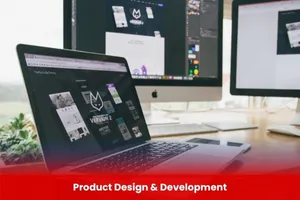Product Design & Development
At BURAAQ UK, our Product Design & Development program is crafted to bridge the gap between innovative ideas and market-ready products. This course empowers learners to understand and apply the complete lifecycle of a product — from conceptualization and design to prototyping, testing, and final production.With a focus on practical design thinking, engineering fundamentals, and modern digital tools, this course provides a hands-on approach to turning concepts into functional, user-centered solutions. Whether it’s mechanical components, consumer electronics, or industrial systems, BURAAQ UK trains students and professionals to design with purpose, efficiency, and manufacturability in mind.

Aim of Product Design & Development
The aim of the Product Design & Development course at BURAAQ UK is to equip learners with the creative, technical, and analytical skills required to design, develop, and refine innovative products—from initial concept to functional prototype—using industry-standard tools, engineering principles, and design thinking methodologies.
Course Overview
Product Design & Development
- Educational Background
- Minimum Requirement:
- Completion of secondary education (Matric / GCSE / O-Level or equivalent)
- Preferred Qualifications:
- Diploma (DAE) or Degree in:
- Mechanical / Electrical / Mechatronics Engineering
- Industrial Design or Product Design
- Computer-Aided Design (CAD), Manufacturing, or related fields
- Diploma (DAE) or Degree in:
- Skills & Knowledge (Preferred but not mandatory)
- Basic understanding of:
- Engineering concepts (mechanical or electrical)
- Drawing and drafting (manual or CAD)
- Materials and manufacturing processes
- Suitable For
- Engineering students and graduates
- Product designers, CAD technicians, or prototyping professionals
- Technicians and innovators in manufacturing or R&D departments
- Entrepreneurs and startups interested in developing physical products
- Language & Computer Literacy
- Basic English proficiency (for instruction and software use)
- Comfortable using a computer and design software (CAD, 3D modeling, etc.)
| Course Code | Curriculum Title | Credit | DLH |
|---|---|---|---|
| BUK1389-1 | Introduction to Product Design & Innovation | 3 | 15 |
| BUK1389-2 | Idea Generation & Concept Development | 3 | 15 |
| BUK1389-3 | Engineering Fundamentals for Product Design | 3 | 15 |
| BUK1389-4 | 3D Modeling & CAD Design | 3 | 15 |
| BUK1389-5 | Materials & Manufacturing Processes | 3 | 15 |
| BUK1389-6 | Prototyping & Testing | 3 | 15 |
Module 1: Introduction to Product Design & Innovation
- What is product design?
- Importance of design in industry
- Types of products: consumer, industrial, digital-mechanical systems
- Introduction to design thinking and user-centered design
Module 2: Idea Generation & Concept Development
- Creative thinking methods: brainstorming, mind mapping
- Market research and user need analysis
- Product sketching and visual storytelling
- Concept selection and evaluation techniques
Module 3: Engineering Fundamentals for Product Design
- Mechanical and electrical considerations in design
- Tolerances, fits, and functional design basics
- Integration of electronics (for electromechanical products)
Module 4: 3D Modeling & CAD Design
- Introduction to 3D design software (e.g., SolidWorks, Fusion 360)
- Creating 3D parts, assemblies, and exploded views
- Rendering for presentations
- Technical drawing generation from models
Module 5: Materials & Manufacturing Processes
- Material selection based on product requirements
- Overview of plastics, metals, composites
- Design for manufacturability (DFM)
- Common production processes: injection molding, CNC, 3D printing
Module 6: Prototyping & Testing
- Types of prototypes: visual, functional, pre-production
- Rapid prototyping methods: 3D printing, laser cutting, breadboarding
- Basic testing and validation techniques
- Iterative design and feedback loops
Module 7: Design for Usability & Ergonomics
- Human-centered design principles
- Product interaction and user experience (UX)
- Safety, compliance, and accessibility
Module 8: Product Development Lifecycle & Project Management
- Stages from concept to launch
- Product lifecycle management (PLM) basics
- Costing, scheduling, and risk analysis
- Team collaboration and documentation
Module 9: Final Project – Design to Prototype
- Learners choose or are assigned a product challenge
- Complete process: idea > CAD design > prototype > documentation
- Presentations and design review with feedback
- Students & Graduates
- Technicians & Professionals
- Innovators, Entrepreneurs & Career Switchers
- Creative & Technical Thinkers
- International Learners
- All Modules within this qualification are assessed internally by the approved training Centre and externally verified by BURRAQ UK. The program uses a criterion-referenced assessment approach to ensure that learners successfully meet all required learning outcomes.
- A Pass in any unit is granted only when the learner submits valid, reliable, and authentic evidence that demonstrates achievement of the assessment criteria. The Assessor is responsible for reviewing this evidence and confirming that the learner has attained the expected standard.
